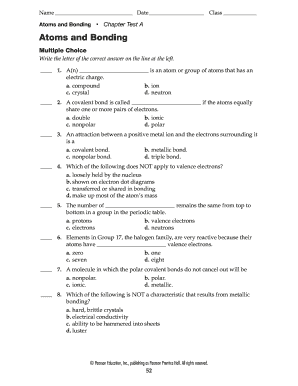
Atoms and Bonding Chapter Test Form


What is the Atoms And Bonding Chapter Test
The Atoms and Bonding Chapter Test is a comprehensive assessment designed to evaluate students' understanding of fundamental concepts related to atomic structure and chemical bonding. This test typically covers topics such as atomic theory, electron configurations, types of chemical bonds, and molecular geometry. It serves as an essential tool for educators to gauge student comprehension and readiness for advanced topics in chemistry.
How to use the Atoms And Bonding Chapter Test
Using the Atoms and Bonding Chapter Test effectively involves several steps. First, ensure that students have a solid grasp of the material covered in the corresponding chapter. Next, administer the test in a controlled environment to minimize distractions. After the test, review the answers with students to reinforce learning and address any misunderstandings. This approach not only assesses knowledge but also enhances the learning experience.
Steps to complete the Atoms And Bonding Chapter Test
Completing the Atoms and Bonding Chapter Test involves a structured approach to ensure accuracy and understanding. Follow these steps:
- Read each question carefully to understand what is being asked.
- Refer back to your notes or textbook for concepts that may need clarification.
- Answer the questions to the best of your ability, ensuring that you show your work where applicable.
- Review your answers before submitting the test to catch any mistakes.
Legal use of the Atoms And Bonding Chapter Test
The legal use of the Atoms and Bonding Chapter Test primarily revolves around educational integrity. It is essential to ensure that the test is administered fairly and that students are given appropriate accommodations if necessary. Additionally, educators should respect copyright laws when using published materials or resources in conjunction with the test.
Key elements of the Atoms And Bonding Chapter Test
Key elements of the Atoms and Bonding Chapter Test include:
- Clear instructions for students on how to complete the test.
- A variety of question types, such as multiple-choice, short answer, and problem-solving.
- Scoring rubrics that outline how answers will be evaluated.
- Feedback mechanisms for students to understand their performance.
Examples of using the Atoms And Bonding Chapter Test
Examples of using the Atoms and Bonding Chapter Test can vary based on educational settings. For instance, teachers may use the test as a mid-term assessment to evaluate student progress. Additionally, it can serve as a review tool before final exams, helping students identify areas where they need further study. Incorporating group discussions based on test questions can also enhance understanding and retention of the material.
Quick guide on how to complete atoms and bonding chapter test
Complete atoms and bonding chapter test effortlessly on any device
Online document management has gained popularity among businesses and individuals. It offers a perfect eco-friendly alternative to traditional printed and signed documents, as you can find the appropriate form and securely store it online. airSlate SignNow provides you with all the tools necessary to create, edit, and eSign your documents quickly without delays. Manage atoms and bonding chapter test on any platform with airSlate SignNow Android or iOS applications and simplify any document-related task today.
How to modify and eSign atoms and bonding chapter test without the hassle
- Obtain atoms and bonding chapter test and click Get Form to begin.
- Utilize the tools we offer to complete your form.
- Emphasize important sections of the documents or redact sensitive information with tools that airSlate SignNow provides specifically for that purpose.
- Create your eSignature with the Sign tool, which takes only seconds and holds the same legal validity as a traditional handwritten signature.
- Review all the details and click on the Done button to save your changes.
- Choose how you wish to submit your form, via email, text message (SMS), or invitation link, or download it to your computer.
Forget about lost or misplaced files, tedious form searching, or mistakes that necessitate printing new document copies. airSlate SignNow meets your document management needs in just a few clicks from any device of your preference. Modify and eSign atoms and bonding chapter test while ensuring exceptional communication at any stage of the form preparation process with airSlate SignNow.
Create this form in 5 minutes or less
Create this form in 5 minutes!
How to create an eSignature for the atoms and bonding chapter test
How to create an electronic signature for a PDF online
How to create an electronic signature for a PDF in Google Chrome
How to create an e-signature for signing PDFs in Gmail
How to create an e-signature right from your smartphone
How to create an e-signature for a PDF on iOS
How to create an e-signature for a PDF on Android
People also ask atoms and bonding chapter test
-
What is the atoms and bonding chapter test in airSlate SignNow?
The atoms and bonding chapter test in airSlate SignNow is a comprehensive assessment that evaluates your understanding of atomic structures and chemical bonding. This test includes various question formats to challenge your knowledge and ensure you grasp the fundamental concepts of chemistry.
-
How can I access the atoms and bonding chapter test?
You can easily access the atoms and bonding chapter test through your airSlate SignNow account. Simply log in, navigate to the educational resources section, and select the test to begin. This streamlined process ensures you can focus on learning without any technical hassles.
-
Is the atoms and bonding chapter test suitable for all students?
Yes, the atoms and bonding chapter test is designed for students at various education levels, from high school to college. Whether you're just starting or need a refresher, this test meets the learning needs of diverse audiences looking to comprehend atoms and bonding.
-
What are the benefits of taking the atoms and bonding chapter test?
Taking the atoms and bonding chapter test helps solidify your understanding of key chemistry concepts. It allows you to identify your strengths and weaknesses, enabling focused study sessions. This targeted feedback is crucial for achieving academic success in chemistry coursework.
-
How much does the atoms and bonding chapter test cost?
The atoms and bonding chapter test is included in the overall subscription to airSlate SignNow's educational solutions. Depending on your chosen plan, you can enjoy access to this valuable test at a competitive price that provides great value for students and educators alike.
-
Can I integrate the atoms and bonding chapter test with other learning tools?
Yes, airSlate SignNow allows for various integrations with popular learning tools and educational platforms. This flexibility ensures you can seamlessly incorporate the atoms and bonding chapter test into your existing curriculum, creating a cohesive learning environment.
-
What features does the atoms and bonding chapter test offer?
The atoms and bonding chapter test features a variety of question types, including multiple-choice and short-answer formats. It also provides instant feedback and scoring to help you track your performance over time. Such features enhance the learning experience and ensure mastery of complex topics.
Get more for atoms and bonding chapter test
- Ir 001 application for records account nevada dmv form
- Mv6641 2017 2019 form
- Single vehicle only form
- Estimated effective rate computation unemployment taxes form
- Storage lien foreclosure form vtr 265 s txdmvgov
- Isbn 978 85 8015 040 7 cadernos pde volume ii vers o online o professor pde e os desafios da escola p blica paranaense produ o form
- Brazil taming inflation expectations banco central do brasil form
- A model of rural conflict violence and land reform policy in brazil
Find out other atoms and bonding chapter test
- How Do I eSign Hawaii Non-Profit PDF
- How To eSign Hawaii Non-Profit Word
- How Do I eSign Hawaii Non-Profit Presentation
- How Do I eSign Maryland Non-Profit Word
- Help Me With eSign New Jersey Legal PDF
- How To eSign New York Legal Form
- How Can I eSign North Carolina Non-Profit Document
- How To eSign Vermont Non-Profit Presentation
- How Do I eSign Hawaii Orthodontists PDF
- How Can I eSign Colorado Plumbing PDF
- Can I eSign Hawaii Plumbing PDF
- How Do I eSign Hawaii Plumbing Form
- Can I eSign Hawaii Plumbing Form
- How To eSign Hawaii Plumbing Word
- Help Me With eSign Hawaii Plumbing Document
- How To eSign Hawaii Plumbing Presentation
- How To eSign Maryland Plumbing Document
- How Do I eSign Mississippi Plumbing Word
- Can I eSign New Jersey Plumbing Form
- How Can I eSign Wisconsin Plumbing PPT